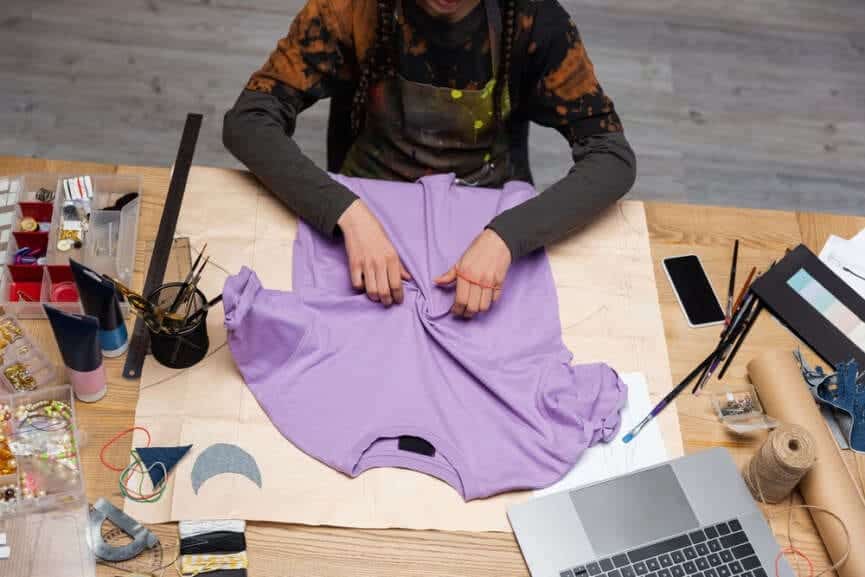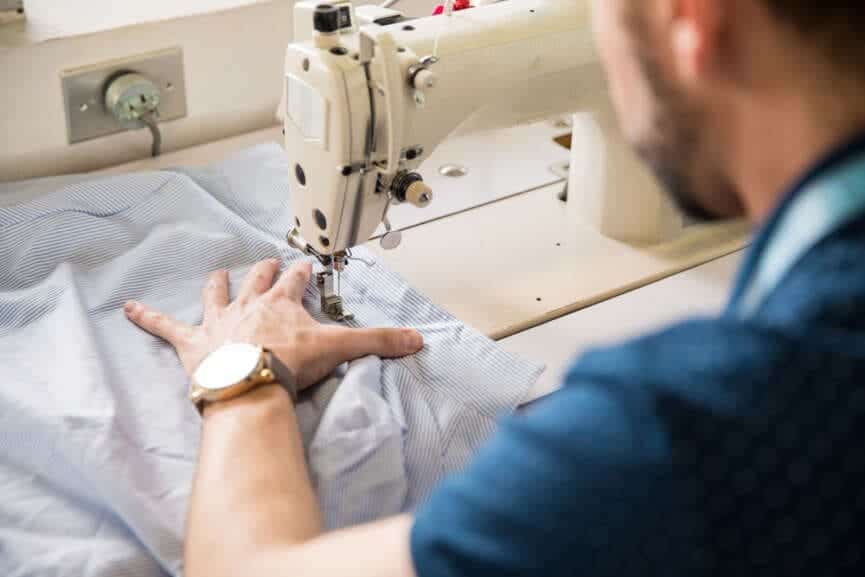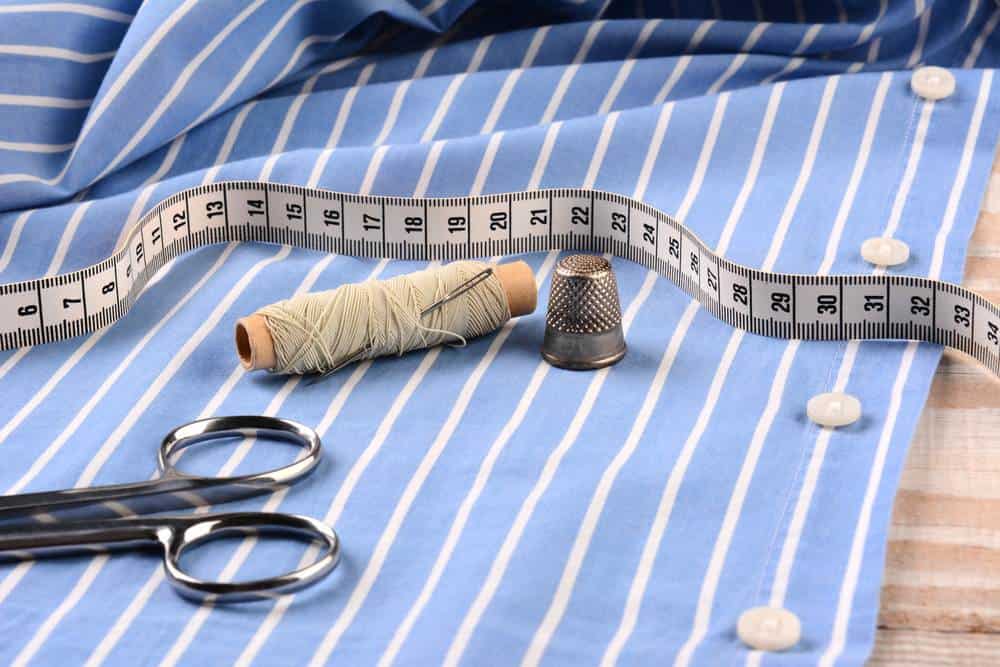In the ever-evolving world of fast fashion, there are times when our wardrobes fall short, quite literally. Get it?
Anyway…You may have a beautiful top piece that fits you perfectly in every way except for one crucial detail—it’s just a tad too short.
Perhaps you love wearing leggings, but you wish your top would provide a bit more coverage, you know, so one won’t be ashamed. Or just for those times when you want to feel extra confident. Well, fret not!
In this piece, we’re going to give you a guide that helps to solve this issue, DIY style. With this, not only will this extend the life of your favorite tops or shirts, but it will also add a touch of style and personal individuality to your outfit’s vibe.
Sounds good? Okay, let’s learn how to sew your very own shirt extender.

1. Materials You’ll Need:
Alright, just one thing: before you embark on your shirt extender sewing journey, It’s time to gather the necessary materials. Here’s what you’ll need to do this properly.
- 1 yard of 44” wide fabric
- 1 yard 4” lace trim
- 1 yard of 3/8” elastic
- ¼ yard Main woven fabric
- Matching Thread
- Scissors
- Rotary Cutter, Cutting Mat, & Ruler
- Washable marker
- Sewing Machine
- Iron or heat press
- Thread Clippers
- Sewing Clips
If you are having any trouble finding them, do not worry! Materials for this are readily available at many local fabric stores or online.
However, remember, these numbers are based on the standard size so, it might change depending on what you are trying to achieve with you craft.
But hey..It always make sence to stay ready with right materials.

2. Why Sew a Shirt Extender?
Okay, now it is time to start the cutting process. Let’s begin this by understanding what the end result should be. So, we make a better decision while cutting and adding finishing touches.
There are several compelling factors you should keep in mind, as these are essential components and that should be present in a quality shirt: Namely, Fashionable Flexibility, Customizable Length, Cost-Effective, and Sustainability. Let’s explore this factor a little further.
2.1 Fashion Flexibility
First, Shirt extenders are incredibly versatile. They can be worn with various outfits, from leggings and jeans to skirts and dresses.
Also, the shirt extender allows you to create a level of comfort or even unique looks without breaking the bank. So, it makes sense. If you are doing it DIV, you ensure fashion flexibility by using the right comfortable but good-looking fabric.
2.2 Customizable Length
The second is to ensure the customizable length. Have you ever struggled to find the perfect top or shirt that hits at just the right size? By mastering this art of making your own shirt extenders, you can experiment with the length to find the perfect fit that works best for you.
So, how do you ensure customizable length? You can easily do this by measuring your waist to the desired length, and you’re in control.
2.3 Cost-Effective
The third factor is simple and does affect the final result however much. But still, it makes sure you do this cost-effectively as a thumb rule. Basically, purchasing ready-made shirt extenders from stores can be costly.
When you sew the extender on your own, you can save a significant amount of money, especially if you buy fabric in bulk. Also, with some creativity and sewing skills, you can make extenders a personal fashion statement without breaking your bank.
2.4 Sustainability
the last factor is just ensuring sustainability. Reducing waste is essential for any DIY projects like sewing shirt extenders. One simple way to do this is that you can repurpose old fabrics or use other sustainable materials to create your extenders.

3. The Cutting Process:
The first step in creating your shirt extender is cutting the fabric. Follow these simple instructions:
- First of all, measure your hips and waist (no lies). These measurements will help you determine the size of your extender. Remember, making a mistake here ruins the comfort.
- Now, decide on the finished length of your extender. A common length is around 11 inches; however, feel free to adjust it to your preference.
- It’s time to cut your fabric pieces to measure 44” x 18”. This provides ample fabric for your extender.
- The next step is to trim the width of the fabric (the 44” side) to match your hip measurement. As a thumb rule, also add an extra inch to ensure a comfortable fit.
- Finally, now adjust the length so that it matches your desired finished length. For example, if you want your extender to be 11 inches long, the unfinished length would be 9 inches. So, for better comfort, include the additional 2 inches (subtracting the 4” trim).

4. Adding the Decorative Trim:
Now, if you want to add a touch of style to your shirt extender by attaching decorative trim. Here’s the way to do it:
- The first step is to begin by folding over one of the raw edges of the fabric by ¼” lengthwise and pressing it with a warm iron.
- The second step is to place your fabric piece on a flat surface with the wrong side facing up. Remember, where the fold becomes the “south end,” and the raw edge is the “north end.”
- The third step is to position the lace trim on the fabric so that the raw edge of the trim aligns with the pressed fold (the south end).
- The fourth step is to pin or clip the trim into place and, using a ¼” seam allowance, sew a straight line close to the open edge of the trim.
- Okay, good job, now to the fifth step: after securing the trim, flip the fabric right side up and turn it so that the south end becomes the right side, and the raw edge faces the left side. Now, finish it gently, press the new seam down and pin it in place.
- Finally, for the last step, just head back to your sewing machine and, using a ¼” seam allowance, sew another straight line close to the open edge.
Hopefully, by following these steps above, you’ll have a beautifully decorated shirt extender with a beautiful decorative trim that also has both proper length and style/vibe to your shirts.

Closing Thoughts
Congratulations! You just successfully made a fashion statements with our t-shirt extenders. Hopefully, our step-by-step shirt tee extender tutorial has ensured that you can effortlessly add length to your tees while giving it perfect or extra length you need.
Also, By using the zigzag stitch technique, we outline, on the top edge, you can easily create a visually appealing extra layer, by giving you the extra coverage you’ve always desired.
Which will help you get fabulous layered look. So, what are you waiting for? Begin Today, happy sewing!








3 Comments
Absolutely, I love the creative approach to solving wardrobe dilemmas by turning them into opportunities for self-expression.
I found this article on sewing a shirt extender truly helpful and creative. In a world of fast fashion, it’s common to face the dilemma of a slightly short favorite top. The DIY guide not only addresses this issue but also adds a stylish and personal touch to outfits. Exploring practical solutions like this is what makes navigating fashion trends enjoyable and sustainable.
The addition of decorative trim is a delightful touch, allowing readers to personalize their shirt extenders and add a touch of style to their wardrobe. The step-by-step guide for adding the trim is well-illustrated, making it easy for readers to follow along and achieve a professional-looking result. It successfully combines practical guidance with an inviting tone, making it an enjoyable and informative read for anyone looking to enhance their wardrobe through a shirt extender.